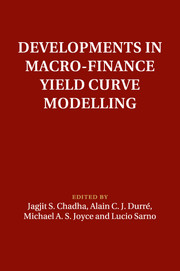Foreword
Published online by Cambridge University Press: 05 February 2014
Summary
Macroeconomics and finance are often housed within separate faculties in universities, and within separate divisions in central banks. In the real world, however, the two are intimately related. Savers, borrowers and investors meet through financial markets and institutions. Insurance markets support the pooling, distribution and diversification of risks. Money markets underpin the most basic plumbing of modern economies: the payment systems through which we pay for goods and services, in different currencies, anywhere in the world. Banks combine the provision of credit, payments and liquidity-insurance services. Finance matters to macro, and vice versa!
Finance theory has made real progress over the past couple of decades in modelling yield curves. Armed with, admittedly strong, ‘no arbitrage’ assumptions that risk is priced consistently across the bond market at all times, this allowed a measure of the markets' beliefs about the path of short-term interest rates to be derived from the term structure of forward interest rates. Together with similar information from index-linked government debt, this unlocked the extraction of estimates of inflation expectations at different horizons – vitally important for monetary policy makers, and also for legislators and the public in holding independent central banks accountable for the price-stability goal they have set us.
Although no-arbitrage provides a means of deriving risk premia, measuring and explaining the various risk premia priced into different financial contracts remains one of the biggest challenges for macro-finance. This is not only a technical question for finance.
- Type
- Chapter
- Information
- Developments in Macro-Finance Yield Curve Modelling , pp. xix - xxiiPublisher: Cambridge University PressPrint publication year: 2014

